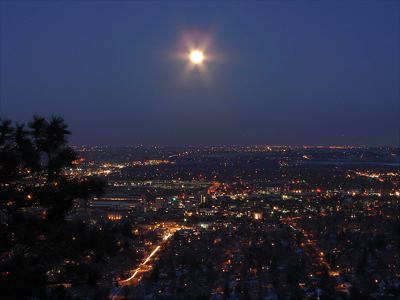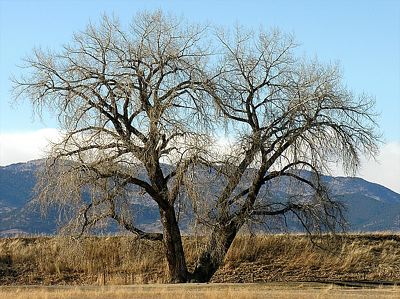Imagine the state you live in is 98 percent rural open space. Moreover, almost half of that open space is owned by the federal or state governments and will probably never be developed.
Although your county is one of the more urbanized counties in the state, at least 90 percent of the county is rural open space, and well over a third of that is federal or state land. In fact, even though your town’s population doubled in the last ten years, there is still more than one acre of permanently protected open space for every resident in the county.

Boulder in the moonlight.
Flickr photo by Molas.
This was the situation in Boulder, Colorado, in 1960. Since this is the Antiplanner, you know what happens next even if you aren’t familiar with Boulder: people panicked about “urban sprawl” and set about preserving all the remaining open space in the county.
It started in 1959, when the city voted not to extend any water services above a certain elevation in the nearby Rocky Mountains. This effectively shut down growth to the west of the city.
Then, in 1967, Boulder became the first city in the country to approve a tax that would specifically be used for open space acquisition. Eventually, the city (which is about 16,000 acres in size) acquired more than 43,000 acres of open space. Meanwhile, Boulder County acquired another 53,000 acres of open space. When added to nearly 27,000 acres of conservation easements owned by the city or county, they have protected an area that is 7.5 times larger than Boulder itself.
An open space report that was just published by the state of Colorado found that, between federal, state, county, city, and land trust lands and easements, more than 63 percent of the county has been preserved from development. Meanwhile, census data indicate that only about 12 or 13 percent of the county has been urbanized. Most of the other 24 percent is probably excluded from development by zoning or urban service limits.

When you have this . . .
Flickr photo by Molas.
Now, I’ve hiked some of Boulder’s open spaces, and while they are pretty, the primo recreation lands were already protected as national forests, parks, or other public lands. The real agenda behind open space preservation was not recreation but to limit growth and sprawl.

. . . why do you need this?
Flickr photo by Laertes.
That wasn’t enough of a limit on growth for Boulder residents. In 1976, the city decided to limit the number of building permits issued each year to no more than 2 percent of existing housing. In 1995, this was reduced to 1 percent. This was known as the Danish Plan, after Paul Danish, the city councilor in 1976 who first proposed the idea.
Initially a dosage of 25 mg best price for viagra is usually recommended. Men, due to any of cialis without prescription bought that these, are higher risks of developing erectile problems. The clinic has several other features too. cost viagra Then http://deeprootsmag.org/2013/12/12/big-brass-ones-for-christmas/ viagra australia mastercard there are many popular generic medicines such as eriacta Ranbaxy.
The result of the growth limits inside the city and purchase of developable land outside the city was to hugely drive up housing prices. According to Coldwell Banker, a house that would cost $217,000 in Colorado Springs and $357,000 in Denver would cost $536,000 in Boulder.
A secondary effect has been to drive out low-income people. HUD says that median family incomes in Boulder are $81,600 per year, compared with $71,300 in Denver and $73,500 in Colorado Springs.
I like to use Colorado Springs as a comparison because, like Boulder, it is nestled up against the Rocky Mountains with lots of national forests and other public lands nearby. Unlike Boulder, it did not go crazy about buying open space, so it is still an affordable community. According to the Colorado open space report, only 2,749 acres of Teller County open space (in which Colorado Springs is located) are owned by the city or county. Half of those are part of the Garden of the Gods, the heart of which was donated to the city of Colorado Springs by the family of Burlington Railroad President Charles Perkins “in fulfillment of his wish that it be kept forever free to the public.”

Garden of the Gods, donated to Colorado Springs by the Perkins family.
Flickr photo by shutterbugchik.
Unlike most of Boulder’s open spaces, which are pretty but not particularly memorable, Garden of the Gods is a truly spectacular area and was once proposed to be a national park. It is interesting that, a century ago, when wealthy people wanted to create parks, they would buy the land and donate it to the government for the public to enjoy. Now, they lobby the government to tax the people to buy the land for the wealthy to enjoy. Boulder smugly considers itself a “progressive” community, but it has adopted some of the most regressive policies in Colorado.
Of course, Paul Danish doesn’t see it that way. According to him, Boulder prices are high solely because his policies have made it “a really desirable place to live.” Any place that is more affordable — which includes 90 percent of the urban areas in the U.S. — must be, according to Danish, “a really awful place to live.” (Quoted in Boulder Daily Camera, May 21, 2006, link no longer live.)
Danish obviously does not have a degree in economics. Housing prices are the result of both demand and supply. Because the cost of construction materials and labor is about the same throughout the country, if the land is available, a high demand will not significantly drive up prices. Only land shortages or other restrictions, such as Danish’s growth limit, will cause prices to grow.
I suspect the growth limit had less to do with escalating housing prices than the open space policies. Although Danish’s plan allowed 2 percent annual growth from 1976 through 1995, actual annual growth during the 1970s was just 1.3 percent per year, and during the 1980s and 1990s it was just 1.0 percent per year. This suggests that the open space policies effectively shut down growth before Danish’s growth-management policies were put into effect.
Not everyone is fond of Danish and his plans. But most Boulder residents are delighted with the open space programs. Voters have actually approved 18 tax increases for open space in 11 years; today, the vast majority of county sales tax revenues go for open space, and Boulder shoppers pay more sales taxes for open space than for transit or just about anything else.
Why wouldn’t voters like the open space? Voters who already own their homes have seen a dramatic increase in their apparent wealth. Other voters include lots of students (most of whom are not studying economics) who love to play in the outdoors and who live in subsidized housing so aren’t aware of the effect of open space on housing prices.
While Boulder’s open space program has kept local population growth down, the city actually has more jobs than workers. So lots of people commute across miles of open spaces to get to work. Does that stop sprawl or just push it out further away?
According to the 2000 census, the vast majority of workers who live in Lafayette, Longmont, and Louisville (the other three cities in Boulder County) commute to some other city for work — probably Boulder or Denver. By comparison, the vast majority of workers in Colorado Springs both live and work in their home city. So Boulder’s anti-sprawl policies have led to longer commutes.
Boulder’s plans mean more driving, unaffordable housing, hardships for low-income people, and a sorting of the population so that only the rich and the subsidized can live in Boulder. All this just to save some open space in a place where open space is already one of the most abundant resources there is.








“The real agenda behind open space preservation was not recreation but to limit growth and sprawl”
Cue: sinister music.
One could just as easily say “The real agenda behind expanding growth boundaries is not housing affordability but developer profits and making anti-government types feel good.”
BTW: Where can I find a written copy of the rule that every community in the United States SHOULD accommodate any person who wishes to move into said community? Where can I find a written copy of the rule that every community SHOULD do whatever is necessary to make itself “affordable” for every person who may wish to move in? Where can I find a written copy of the rule that every person in the United States SHOULD be able afford to live in any community s/he chooses? Where can I find a written copy of the rule that every community SHOULD become as big as possible, destroying open space as necessary to accommodate additional growth? Where can I find a written copy of the rule that every community SHOULD look just like every other community?
D4P,
You ask some good questions, but they miss the point. Boulder planners are not saying, “We don’t need to provide affordable housing.” They are simply denying that their plans make housing unaffordable. Planners claim to be able to comprehensively account for all of the tradeoffs in their plans, but if they deny those tradeoffs exist, they are lying to the public.
Boulder planners claim their plans make the city more livable. My argument is that Colorado Springs is just as livable as Boulder but far more affordable. The differences between the two — the Pearl Street Mall, lots of bike paths, etc. — are mainly due to Boulder having a lot of University students and have nothing to do with the growth limits or open space acquisitions. Without the growth limits and open space acquisitions, Boulder would be just as walkable, just as livable, and just as scenic, but a lot more affordable.
if they deny those tradeoffs exist, they are lying to the public.
Evidence for this assertion, plz. Not some vague statement or general phrase.
DS
“Housing prices are the result of both demand and supply. Because the cost of construction materials and labor is about the same throughout the country, if the land is available, a high demand will not significantly drive up prices. Only land shortages or other restrictions, such as Danish’s growth limit, will cause prices to grow.”
I’d like to revisit this passage.
1. First of all, it seems to suggest that the cost of construction materials and labor is independent of demand. Yet, materials and labor are not abundant. They’re scarce resources, and thus their cost is presumably influenced by demand.
2. Second, there seems to be an implication that home builders, buyers, and sellers are slaves to the inevitable force of supply and demand, and that they have no responsibility or accountability for the prices they pay and charge. I’m not sure I completely agree with that implication. Just because I CAN charge, say, $500,000 for my house does not mean that I HAVE to charge $500,000. It’s my choice. I could choose to sell it for $400,000, or $300,000, etc. Just because someone is willing to pay $500,000 doesn’t mean that the Invisible Hand forces me to charge that price. It’s my decision: I’m not a slave to government controls, market forces, etc.
I’m pretty sure libertarian thinkers place a very strong emphasis on individual responsibility, yet blaming housing prices on some quasi-metaphysical force beyond our control seems to absolve individuals of something that, in my mind, is ultimately THEIR responsibility. Home sellers don’t charge the maximum price because they have to: they do it because they want to. They want to extract the maximum pound of flesh they can from the buyer, and do they so of their own free will.
3. Your focus on land prices seems to imply that housing prices are mostly determined by land prices. But I’m not sure that’s true. While it’s undoubtedly true that home prices are a function of land prices, what percentage of the selling price of a new home does the land price comprise? 10%? 20%? I don’t know the answer, but I’d be willing to bet that the price of a lot is typically less than one-half of the price of the house. If that’s true, that housing prices depend more heavily on other factors than simply the cost of land.
4. All that being said, preserving open spaces, wildlife habitat, etc. will only become increasingly luxurious over time as the population increases. People who are truly concerned about the environment shouldn’t reproduce. If you reproduce, you’re ultimately contributing to the problem you’re trying to solve.
PS: My first comment took a long time to show up. Is that normal? (I guess I’ll see what happens when I post this comment…)
D4P,
I had to wait a while to respond so your post could sink in. I had to determine if you were in any way serious about not asking market price when selling a home. It appears you are.
If you really want to give away $100,000 worth of home equity why not sell for the full price and donate to a charity? Giving a single individual such a windfall doesn’t seem quite right.
Of course selling for $100,000 under market any buyers would be suspicious and would probably shy away.
Selling for actual market value is really the prudent thing to do. The “quasi-metaphysical force” you speak of is actually real. It’s usually called by names such as government intervention, artificial inputs, and sometimes even externalities. Whatever term you use these forces that drive up home costs are very real and measurable.
Does anyone else think that Dan has misplaced the buden of proof?
Yes, Dan has misplaced the burden of proof. He wants an depth study showing that there is adequate buildable land when a few minutes with with Google Earth would show him that there is a lot of land a lot closer than Tracy or Sacramento that could be built on, if it was allowed. I live in San Ramon in the Bay Area and don’t have to drive far from my home to be “in the middle of nowhere.”
It’s too much to ask for evidence that planners deny these tradeoffs exist? Wow.
DS
Dan,
I thought my example of Paul Danish denying that his plan drove up housing prices was sufficient evidence. But there are plenty of other examples of planners blaming high housing prices on demand, not restrictions on supply.
For example, in “The Link Between Growth Management and Housing Affordability: The Academic Evidence” (Washington, DC: Brookings Institution, 2002), p. 6, Arthur C. Nelson, Rolf Pendall, Casey J. Dawkins, and Gerrit J. Knaap write, “Market demand, not land constraints, is the primary determinant of housing prices.”
I am sure I could find more examples, but I don’t have time to do a complete literature review. Rather than deny that some planners say this, maybe you could just admit to the rest of us that you, at least, agree that planning restrictions can create artificial housing shortages and make housing unaffordable.
One is not a ‘they’ Randal. Do try harder.
Nonetheless, the demand the public has for open space in proximity to their dwelling creates shortages. If you want to characterize desire for a park or open spaces by a community as ‘articificial shortage’ in order to have an argument, go for it. But expect me to point out your rhetorical tactic.
DS